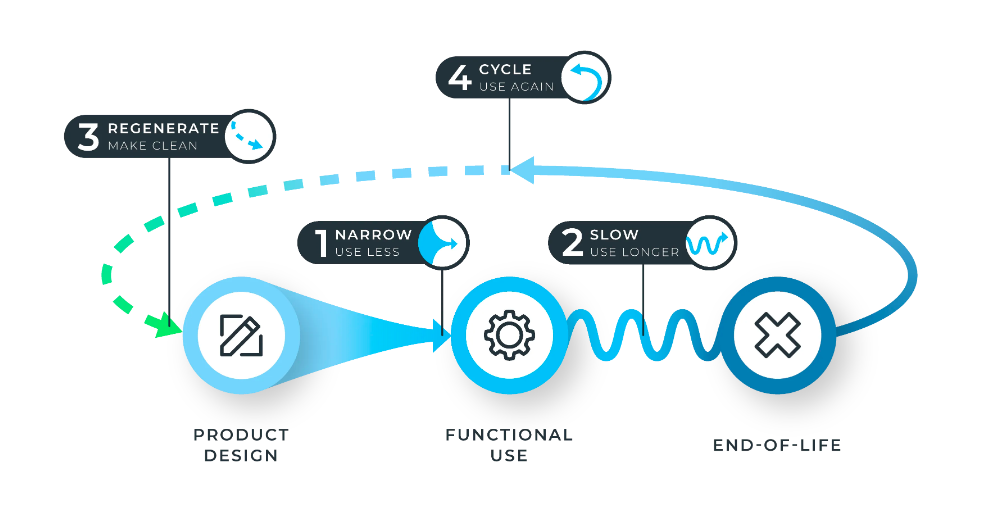The Circularity Gap Report 2023: The global economy is only 7,2% circular
We live in the overshoot era where the global situation is getting worse year on year, states the 2023 Circularity Gap Report. Rising material extraction has shrunk global circularity: from 9.1% in 2018, to 8.6% 2020, and now 7.2% in 2023. This leaves a huge Circularity Gap: the globe almost exclusively relies on new (virgin) materials.
The Circularity Metric
Circular inputs measure the share of secondary materials that are cycled back into the economy from waste. The world’s circularity keeps shrinking not simply because we’re failing to cycle more – it’s also due to increasing virgin extraction and the fact that we are putting more and more materials into stocks like roads, homes and durable goods. This means that the global economy cannot cycle enough to create a truly closed-loop of consumption: without significantly reducing material use, it’s inevitable that the Circularity Metric will continue to fall.
Material extraction is rising every year
Each year we have smashed through the planet’s safe environmental limits. Today, five of the nine key ‘planetary boundaries’ that measure environmental health across land, water and air have been broken.
Worldwide, total material extraction is on the rise: it more than tripled since 1970, but almost doubled since the year 2000 – reaching 100 billion tonnes today.
By 2050 material extraction and use is expected to double relative to 2015 levels, threatening a total breakdown of Earth’s life support systems, which are already at a breaking point. Without material management strategies that keep us within planetary boundaries, the UN has warned of ‘total societal collapse’, driven by concurrent climate change disasters, economic vulnerabilities, political instabilities and ecosystem failures.
To bring human activity back within the safe limits of the planet, we would need to reduce global material extraction and consumption by one-third.
A crucial solution to address this challenge is a circular economy: more than just recycling, increases in secondary material use must be matched by a systemic approach to smart material management that enables doing more with less, using for longer and substituting with sustainably managed regenerative materials. By upgrading to a model that maximises the value that we extract from our precious materials, we can better ensure the wellbeing of present and future generations, while respecting the boundaries of our planet.
How? With four key circular actions: USE LESS, USE LONGER, USE AGAIN and MAKE CLEAN

The graphic above depicts the four flows to achieve circular objectives: narrow, slow, regenerate and cycle. The four objectives are based on the work of Bocken et al. (2016)
The focus must centre on getting more value out of fewer materials. Achieving the aims of a circular economy – minimising material use, regenerating the Earth and preventing material losses – can be done through four key strategies:
1. NARROW: USE LESS
Narrow strategies reduce material and energy use. Currently, material use is highly inefficient and ineffective; we can deliver similar social outcomes by using much less and phasing out fossil fuels, for example. This doesn’t mean being worse off, but rather focussing on using materials efficiently: think in terms of riding a bike instead of driving a car, eating less meat and living in a space that suits your needs. Using less is a core tenet of the circular economy—yet currently, the threshold for sustainable consumption, 8 tonnes per person, is being surpassed by 1.5 times.
2. SLOW: USE LONGER
Slow strategies aim to keep materials in use for as long as possible, for example through design for durability and repairability. A more circular economy is also a slower one: materials, components and products – and even buildings and infrastructure – that we lock in stocks are made to last. This will lower material demand in the long run, in essence also serving to narrow resource flows.
3. REGENERATE: MAKE CLEAN
Regenerate strategies phase out hazardous or toxic materials and processes, and substitute them with regenerative biomass resources. A circular economy aims to mimic natural cycles by shifting to more regenerative farming practices, for example, while also maximising the share of circular biomass that enters the economy. Regeneration can happen both at the systems level (by designing regenerative processes) as well as at the product level (by switching synthetic to organic fertilisers, for example).
4. CYCLE: USE AGAIN
Cycle strategies aim to cycle and reuse materials at their highest value: they maximise the volume of secondary materials re-entering the economy, ultimately minimising the need for virgin material inputs and therefore also narrowing flows. Of course, virgin materials will always be needed to a degree: all materials degrade and can’t be cycled infinitely, use energy, and require blending with virgin materials to maintain strength and functionality
Staying within the safe limits of the planet
The Circularity Gap analysis explores how the global economy can meet people’s needs for nutrition, housing, mobility, and manfuactured goods following circular economy principles. The result? A set of 16 circular solutions have been modelled across four global systems: Food systems, the Built environment, Manufactured goods and consumables, and Mobility and transport.
Dive into the solutions and download the full report here: https://www.circularity-gap.world/2023
//
Article source & images: circularity-gap.world



